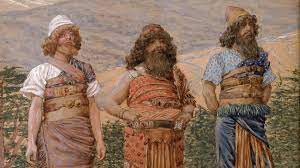The Written Account of the Sons of Noah
10:1 to 11:9

Moses edited and compiled eleven family documents in the book of Genesis. The major structural word for Genesis is toldot, which means the written account of, or this is what became of these men and their descendants. The noun is often translated generations, histories or descendants. After the section on the written account of the generations of Noah from 6:9 to 9:29, we have the fifth toldot , the written account of the Sons of Noah. The previous toldot went from the judgment of the Flood to the blessing of saving Noah and his family; however, it also went from the blessing of Noah’s righteousness to the curse of Canaan. Therefore, what this fifth family document tells us is what became of Noah’s sons. And what became of Noah’s sons was they went from the blessing of being fruitful and multiplying to the curse of the Tower of Babel.
The name the LORD or ADONAI is used seven times in this section. Because this toldot ends in the divine judgment of a rebellious people, ADONAI emphasizes that He is the One who always exists, the God of redemption and mercy.
This section does not begin with the eldest son Shem, but deals with Japheth and Ham first to dispense with the non-Seed lines. Shem will be the line that the Seed of the woman (3:15), or the Messiah, comes through, so the descendants of Shem will be dealt with last.
The purposes of this section are to show divine providence in the distribution of the nations, to show the relationship of Isra’el to the other nations (Deuteronomy 32:8-9), and to show the unity of humanity.
With very few variations, this section is copied in First Chronicles 1:4-23 showing that it was quite historical. This document is quite unique in any Near Eastern ancient literature. There are several parallels to the early chapters of Genesis, but none to this chapter. It stands alone.
The names in Chapter 10 fall into four categories. First, some names are listed as individuals. Secondly, some names are listed as tribes. Thirdly, some names are listed as cities. And fourthly, some names are listed as nations.



Leave A Comment